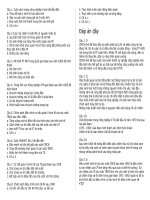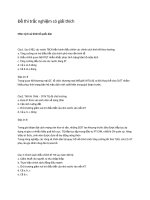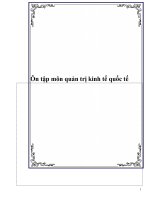Hướng dẫn tự học môn giao tiếp kinh doanh đại học kinh tế quốc dân
Bạn đang xem bản rút gọn của tài liệu. Xem và tải ngay bản đầy đủ của tài liệu tại đây (4.71 MB, 197 trang )
11/23/2016
Business Communication
Introduction
Ch 0. Slide 0
Lecturers
Tran Thi Thu Giang, MBA.
Faculty of Foreign Languages
Room 104 Building 6B, NEU
Mobile: 0912205670
Email:
Le Thi Thu Mai, MBA.
Faculty of Foreign Languages
Room 104 Building 6B, NEU
Mobile: 0946203410
Email:
Ch. 0, Slide 1
1
11/23/2016
Detailed Schedules
Ch. 0, Slide 2
Assessment
Ch. 0, Slide 3
2
11/23/2016
Business Communication
Chapter 1
Communicating in Today’s Workplace
Ch. 1, Slide 5
Objectives of Chapter 1
1 Understand the importance of communication
skills in relation to career success
2 Recognize significant changes in today’s
workplace and how these changes increase the
need for excellent communication skills.
3 Analyze the process of communication and
how to engage it effectively.
4 Recognize barriers to interpersonal
communication and examine specific strategies
for overcoming those barriers.
Ch. 1, Slide 6
3
11/23/2016
Expectations of Workers in
Today’s Information Age
Work with words, figures, and data.
Generate, process, and exchange information.
Think critically.
Make decisions.
Take charge of your career.
Continue learning all your life.
Ch. 1, Slide 7
Trends Affecting You in Today’s Workplace
Heightened global competition
Flattened management hierarchies
Expanded team-based management
Innovative communication technology
New work environments
Increasingly diverse workforce
Renewed emphasis on ethics
Ch. 1, Slide 8
4
11/23/2016
The Communication Process – Basic Model
Noise
Noise
Sender has
idea
1
Noise
Noise
Sender
encodes
idea in
message
Noise
Feedback
5 travels to
sender
2
Noise
Message
travels
over
channel
Possible
additional
feedback to
receiver
4
3
Receiver
decodes
message
Noise
6
Noise
Ch. 1, Slide 9
Factors That Shape Understanding
Communication climate
Context and setting
Background, experiences
Knowledge, mood
Values, beliefs, culture
Ch. 1, Slide 10
5
11/23/2016
Barriers That Create Misunderstandings
Bypassing
Differing frames of reference
Lack of language skills
Poor listening skills
Emotional interference
Physical distractions
Ch. 1, Slide 11
Overcoming Barriers That
Cause Misunderstandings
Realize that communication is imperfect.
Adapt the message to the receiver.
Improve your language and listening skills.
Question your preconceptions.
Encourage feedback.
Ch. 1, Slide 12
6
11/23/2016
Organizational Communication
Functions
Internal
External
New emphasis
Interactive
Mobile
Instant
Forms
Oral
Written
Delivery
Electronic
Hard copy
Ch. 1, Slide 13
Communication and Formal Channels
Written channels
Memos, letters
Annual report
Company newsletter
Bulletin board postings
Orientation manual
Ch. 1, Slide 14
7
11/23/2016
Communication and Formal Channels
Oral channels
Telephone
Face-to-face conversation
Company meetings
Team meetings
Ch. 1, Slide 15
Communication and Formal Channels
Electronic channels
Instant/text messaging
Voicemail
Videoconferencing
Blogging
Social networks
Wikis
Microblogging
Web chat
Ch. 1, Slide 16
8
11/23/2016
Formal Channels of Information Flow
Managers
Supervisors
Policies
Procedures
Directives
Goals and Motivation
Flows from
decision makers
to workers
Subordinates
Ch. 1, Slide 17
Formal Channels of Information Flow
Managers
Supervisors
Feedback
Progress
Problems
Suggestions
Flows from
employees to
decision makers
Subordinates
Ch. 1, Slide 18
9
11/23/2016
Formal Channels of Information Flow
Coworkers
Coworkers
Task coordination, problem solving, conflict
resolution, idea generation, team building,
goals clarification
Flows among workers
at the same level
Ch. 1, Slide 19
Obstacles to the Flow
of Organizational Information
Lack of trust, turf wars, fear of reprisal
Uneven reward systems
Closed communication climate
Little official communication
Top-heavy organizational structure
Long lines of communication
Filtering, prejudice, ego involvement
Poor communication skills
Ch. 1, Slide 20
10
11/23/2016
Surmounting Obstacles to
Effective Communication
Encourage open, trusting environment for interaction and
feedback.
Flatten the organizational structure.
Provide more information through formal channels.
Train managers and employees to improve communication
skills.
Establish hotline and ombudsman programs.
Establish fair reward system for individual and team
achievement.
Encourage full participation in teams
Ch. 1, Slide 21
Overview of Topics in This Chapter
Communication Skills and Career Success
The Communication Process
Barriers to Interpersonal Communication
Flows of Information in Organizations
Barriers to Organizational Communication
Ch. 1, Slide 22
11
11/23/2016
Business Communication
Chapter 2
Developing Team, Listening,
and Etiquette Skills
23
Objectives of Chapter 2
1 Recognize the importance of soft skills and
teamwork in today’s workplace.
2 Understand how to contribute positively to team
performance, including resolving workplace conflicts.
3 Understand the forms of nonverbal communication
and how they can be used to advance your career.
4 Develop a competitive edge with professionalism
and business etiquette skills.
24
12
11/23/2016
What Do Employers Want?
Proven team skills
Strong verbal and written communication skills
Excellent interpersonal and organizational skills
25
Why Teamwork Works
Better decisions
Faster response
Increased productivity
Greater “buy-in”
Less resistance to change
Improved employee morale
Reduced risks
26
13
11/23/2016
Four Phases of Team Development
1
Forming
2
Storming
3
4
Performing
Norming
27
Characteristics of People Who Exhibit
Positive Team Behavior
Set rules and abide by them.
Analyze tasks and define problems.
Contribute information and ideas.
Show interest and listen actively.
Encourage members to participate.
Synthesize points of agreement.
28
14
11/23/2016
Characteristics of People Who Exhibit
Negative Team Behavior
Block ideas of others.
Insult and criticize.
Waste the group's time.
Make inappropriate comments.
Fail to stay on task.
Withdraw, don't participate.
29
How to Resolve Conflict: Six Steps
Reach
an
Invent
agreenew
Look for
ment
common problemShow
based
solving
Under- concern ground
Listen stand
options on what
for the
is fair
other relationship
points
of view
30
15
11/23/2016
Types of Workplace Listening
Listening to superiors
Listening to colleagues and teammates
Listening to customers
31
Ten Keys to Building
Powerful Listening Skills
1. Control internal
and external
distractions.
2. Become actively
involved.
3. Separate facts from
opinions.
4. Identify important
facts.
5. Avoid interrupting.
6. Ask clarifying
questions.
7. Paraphrase to
increase
understanding.
8. Capitalize on lag
time.
9. Take notes.
10. Be aware of gender
differences.
32
16
11/23/2016
Common Listening Barriers
Mental Barriers
Inattention
Prejudgment
Frame of reference
Closed-mindedness
Pseudolistening
Physical and Other
Barriers
Hearing impairment
Noisy surroundings
Speaker’s appearance or
mannerisms
Lag time
33
Functions of Nonverbal Communication
Complement and illustrate
Reinforce and accentuate
Replace and substitute
Control and regulate
Contradict
34
17
11/23/2016
Forms of Nonverbal Communication
Eye contact
Facial expression
Posture and gestures
Time (arrival, length)
Space
Territory
Appearance of documents
Appearance of people
35
How to Gain an Etiquette Edge
Use polite words.
Express sincere appreciation and praise.
Be selective in sharing personal information at
work.
Avoid putting people down.
Respect coworkers’ space.
Rise above others’ rudeness.
Be considerate when sharing space and equipment
with others.
Disagree agreeably.
36
18
11/23/2016
Business Communication
Chapter 3
Intercultural Communication
37
Objectives of Chapter 3
1 Understand significant trends related to the
increasing importance of intercultural
communication for business communicators.
2 Define culture, describe five noteworthy
cultural characteristics, and compare and
contrast five key dimensions of culture including
high and low context.
3 Identify techniques for improving
communication in intercultural environments.
38
19
11/23/2016
Reasons for the Increasing Importance of
Intercultural Communication
The globalization of markets
Technological advancements
Global connectivity
An intercultural workforce
39
Technological Advancements and
Global Interconnectivity
The development of
new transportation
and information
technologies fuel the
explosive growth of
global markets.
The Internet and the
Web are changing
the way we live, the
way we do business,
and the way we
communicate.
40
20
11/23/2016
Expanding Intercultural Workforce
Immigration makes
intercultural
communication
increasingly
necessary.
Business
communicators must
learn to adapt to an
intercultural
workforce and
multinational
companies.
41
Characteristics of Culture
42
21
11/23/2016
Dimensions of Culture
Formality
Communication Style
Individualism
Context
Time
Orientation
Culture
43
Characteristics of High-Context
and Low-Context Cultures
Japanese
Arab
Latin American
Spanish
English
Italian
French
North American
Scandinavian
German
Swiss
High Context
High-context cultures are
relational, collectivist,
intuitive, and contemplative.
Low-context cultures are
logical, linear, individualistic,
and action-oriented.
Low Context
44
22
11/23/2016
How We Form Judgments
Stereotype: An oversimplified behavioral
pattern applied uncritically to groups
Prototype: A mental representation based on
characteristics that are flexible and open to
new definitions
Prejudice: A rigid attitude based on erroneous
beliefs or preconceptions
45
Techniques to Broaden
Your Intercultural Competence
Descriptiveness – giving descriptive feedback
instead of judgmental feedback
Nonjudgmentalism – being tolerant, which
helps prevent defensive reactions
Supportiveness – encouraging others with head
nods, eye contact, and facial expressions
46
23
11/23/2016
Techniques for Bridging the
Gap Between Cultures
Tolerance – being open-minded and
empathetic
Helping others save face – raising their social
standing through positive comments
Patience – for example, letting others express
their thoughts without finishing their sentences
for them
47
How to Improve Oral Communication
With Intercultural Audiences
Learn foreign phrases.
Use simple English.
Speak slowly and enunciate clearly.
Observe eye messages.
Encourage accurate feedback.
Check frequently for comprehension.
Accept blame.
Listen without interrupting.
Smile when appropriate.
Follow up in writing.
48
24
11/23/2016
How to Improve Written Communication
With Intercultural Audiences
Consider local styles.
Observe titles and rank.
Use short sentences and short paragraphs.
Avoid ambiguous expressions.
Strive for clarity.
Use correct grammar.
Cite numbers carefully.
Accommodate readers in organization, tone,
and style.
49
Tips for Improving Communication Among
Diverse Workplace Audiences
Seek training.
Understand the value of
differences.
Don’t expect conformity.
Learn about your cultural
self.
Make fewer assumptions.
Build on similarities.
50
25









